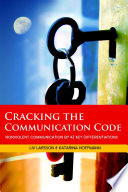

One of the core ideas of 'Cracking the Communication Code' is the importance of recognizing different communication styles. The book outlines various styles such as analytical, driver, expressive, and amiable, each characterized by distinct behaviors and preferences. Understanding these styles is crucial for effective communication, as it allows individuals to tailor their messages to resonate with their audience. For instance, an analytical communicator may prefer data-driven discussions, while an expressive communicator thrives on storytelling and emotional engagement. By identifying and adapting to these styles, one can enhance interpersonal interactions, reduce misunderstandings, and foster stronger relationships both personally and professionally.
Continue readingNon-verbal communication plays a significant role in how messages are conveyed and interpreted. The book emphasizes that body language, facial expressions, and tone of voice can often communicate more than words. For example, crossed arms might suggest defensiveness, while an open posture indicates receptiveness. Understanding these cues can help individuals become more aware of their own non-verbal signals and those of others, leading to more effective communication. The text also discusses the cultural variations in non-verbal communication, highlighting the need for sensitivity and adaptability when interacting with diverse audiences.
Continue readingActive listening is a fundamental skill discussed in the book that involves fully concentrating, understanding, responding, and remembering what is being said. The authors provide practical techniques for enhancing active listening skills, such as maintaining eye contact, nodding, and paraphrasing what the speaker has said. By practicing active listening, individuals can show respect and validation to the speaker, which fosters a more open and honest dialogue. The book argues that effective communication is not just about speaking but also about listening, and that mastering this skill can lead to improved relationships and conflict resolution.
Continue readingEmpathy is highlighted as a crucial component of effective communication. The book explains that being able to put oneself in another's shoes enhances understanding and builds trust. Empathetic communicators are more likely to connect with others on a deeper level, making their interactions more meaningful. The authors provide strategies for developing empathy, such as asking open-ended questions and being genuinely curious about others' perspectives. By fostering empathy, individuals can navigate difficult conversations more effectively and create a supportive environment that encourages collaboration and innovation.
Continue readingThe ability to adapt communication styles to suit different audiences is a key theme in 'Cracking the Communication Code.' The book emphasizes that one-size-fits-all communication strategies are often ineffective. Instead, communicators should assess their audience's preferences, backgrounds, and expectations before crafting their messages. This adaptability not only increases the likelihood of the message being received positively but also demonstrates respect for the audience's unique characteristics. The authors provide case studies and examples of successful adaptations, illustrating the impact of tailored communication in various contexts, from business negotiations to personal relationships.
Continue readingThe book identifies common barriers to effective communication, such as preconceived notions, emotional reactions, and environmental distractions. The authors discuss strategies for overcoming these barriers, such as being aware of one's biases, managing emotions, and creating conducive environments for dialogue. By recognizing and addressing these obstacles, individuals can improve their communication effectiveness and reduce the likelihood of conflicts. The book encourages readers to engage in self-reflection and continuous improvement, emphasizing that effective communication is a skill that can be developed over time.
Continue readingFeedback is presented as a vital component of the communication process in 'Cracking the Communication Code.' The authors argue that giving and receiving feedback is essential for personal and professional growth. They provide guidance on how to deliver constructive feedback in a way that is respectful and actionable, as well as how to receive feedback gracefully. The book highlights that feedback should be seen as an opportunity for improvement rather than criticism, fostering a culture of open communication and continuous learning. By embracing feedback, individuals can enhance their skills and contribute to a more collaborative environment.
Continue reading